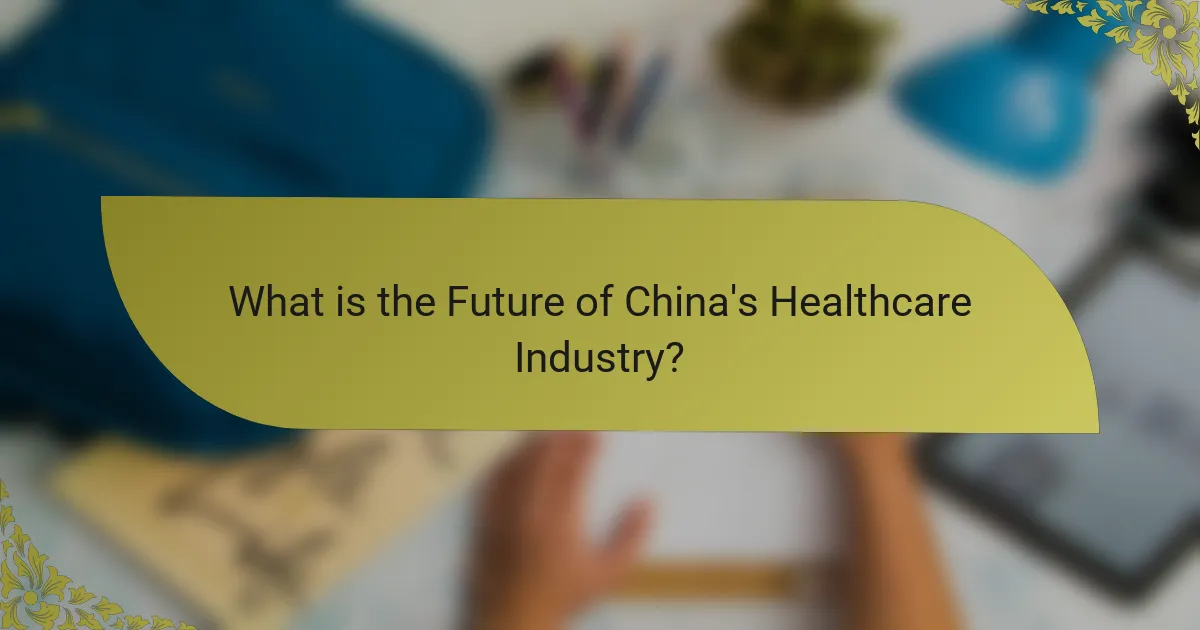China’s healthcare industry is on the brink of substantial transformation, driven by technological advancements, regulatory reforms, and significant market growth. The integration of artificial intelligence and telemedicine is set to improve patient care and accessibility. With healthcare expenditure projected to reach around $1 trillion by 2025, the Chinese government is enacting reforms to enhance healthcare delivery, expand insurance coverage, and increase funding for public health initiatives. Additionally, the aging population is escalating the demand for healthcare services, leading to a rise in private investment within the sector. These developments indicate a rapidly evolving landscape for healthcare in China.

What is the Future of China’s Healthcare Industry?
The future of China’s healthcare industry is poised for significant transformation driven by technological advancements, regulatory changes, and market growth. The integration of artificial intelligence and telemedicine is expected to enhance patient care and accessibility. China’s healthcare expenditure is projected to reach approximately $1 trillion by 2025, indicating substantial market growth. The government is implementing reforms to improve healthcare delivery and efficiency. These reforms include expanding insurance coverage and increasing funding for public health initiatives. Additionally, the aging population is creating a higher demand for healthcare services. As a result, private investment in healthcare is likely to increase. Overall, these factors suggest a dynamic and evolving landscape for China’s healthcare industry.
How are technological advancements shaping China’s healthcare landscape?
Technological advancements are significantly transforming China’s healthcare landscape. Innovations such as telemedicine, artificial intelligence, and big data analytics are improving patient care. Telemedicine allows remote consultations, increasing access to healthcare services in rural areas. Artificial intelligence enhances diagnostic accuracy and treatment personalization. Big data analytics aids in disease prediction and management. These technologies streamline operations and reduce costs for healthcare providers. The Chinese government supports these advancements through policies and funding. For instance, the National Health Commission promotes digital health initiatives. Overall, technology is driving efficiency and accessibility in China’s healthcare system.
What specific technologies are emerging in China’s healthcare sector?
Artificial intelligence, telemedicine, and blockchain are emerging technologies in China’s healthcare sector. Artificial intelligence is used for diagnostics and personalized medicine. Telemedicine facilitates remote consultations, improving access to healthcare services. Blockchain enhances data security and interoperability among healthcare systems. These technologies are driven by China’s increasing investment in health tech. The government supports innovation through policies and funding. For instance, the National Health Commission promotes AI applications in healthcare. These advancements aim to improve patient outcomes and streamline healthcare delivery.
How do these technologies improve patient care and outcomes?
Technologies improve patient care and outcomes by enhancing diagnostic accuracy and treatment efficiency. Advanced imaging technologies, such as MRI and CT scans, enable earlier detection of diseases. Telemedicine allows for remote consultations, increasing access to healthcare. Electronic health records streamline patient information sharing among providers. AI-driven analytics can predict patient deterioration, facilitating timely interventions. Wearable devices monitor vital signs continuously, promoting proactive health management. Studies show that these technologies lead to reduced hospital readmission rates and improved patient satisfaction scores. In China, the integration of these technologies is driving significant advancements in healthcare delivery and outcomes.
What regulatory changes are impacting China’s healthcare industry?
Recent regulatory changes are significantly impacting China’s healthcare industry. The Chinese government has implemented stricter regulations on drug approvals and medical device registrations. These changes aim to enhance the safety and efficacy of healthcare products. Additionally, the government is promoting transparency in pricing and reimbursement processes. This includes reforms in the National Reimbursement Drug List (NRDL). Furthermore, there is an increased focus on data protection and patient privacy regulations. These changes align with global standards and improve public trust in the healthcare system. Overall, these regulatory shifts are reshaping the landscape of healthcare in China.
How are government policies evolving to support healthcare innovation?
Government policies are evolving to support healthcare innovation through increased funding, regulatory flexibility, and public-private partnerships. In China, the government has launched initiatives like the Healthy China 2030 plan, which aims to integrate technology into healthcare services. This plan promotes research and development in medical technologies and encourages startups in the healthcare sector.
Additionally, policies are being enacted to streamline the approval process for new medical devices and pharmaceuticals. For instance, the National Medical Products Administration has reduced the time required for clinical trials. This accelerates the introduction of innovative solutions to the market.
Moreover, the government is fostering collaboration between academic institutions and industry players. This collaboration aims to enhance knowledge transfer and drive innovation. The focus on digital health solutions, such as telemedicine and health data analytics, is also a priority.
Overall, these evolving policies are designed to create a more conducive environment for healthcare innovation, ensuring better health outcomes for the population.
What challenges do these regulatory changes present to healthcare providers?
Regulatory changes present significant challenges to healthcare providers. These challenges include increased compliance costs due to new regulations. Providers must invest in training staff to understand and implement these changes. Additionally, there may be disruptions in service delivery as systems are updated to meet new standards. Providers also face potential penalties for non-compliance, which can impact financial stability. Furthermore, adapting to evolving regulations can divert resources from patient care. These factors can ultimately affect the quality and accessibility of healthcare services.
What factors are driving market growth in China’s healthcare industry?
Increasing demand for healthcare services is driving market growth in China’s healthcare industry. Factors include an aging population, rising chronic diseases, and increased health awareness. The population aged 65 and older is projected to reach 487 million by 2050. This demographic shift leads to higher healthcare needs. Additionally, the prevalence of chronic conditions like diabetes and hypertension is rising, necessitating more medical care. Increased disposable income allows more citizens to afford health services. Government policies are also promoting healthcare investment and innovation. The market size of China’s healthcare industry was valued at approximately $1 trillion in 2021. These factors collectively contribute to the rapid expansion of the sector.
How does the aging population influence healthcare demand?
The aging population significantly increases healthcare demand. As individuals age, they generally experience more chronic health conditions. This leads to a higher need for medical services and long-term care. For instance, the World Health Organization reports that older adults are more likely to require hospitalization and specialized treatments. Additionally, the increasing life expectancy contributes to a growing elderly demographic. In China, the proportion of people aged 65 and older is projected to reach 25% by 2040. This demographic shift necessitates expanded healthcare resources and infrastructure. Consequently, healthcare providers must adapt to meet the rising demand for geriatric care and related services.
What role does investment in healthcare infrastructure play in market expansion?
Investment in healthcare infrastructure is crucial for market expansion. It enhances service delivery and increases access to medical care. Improved infrastructure attracts more patients and boosts healthcare quality. A robust healthcare system fosters trust among consumers. This trust can lead to increased spending on healthcare services. Additionally, investment can stimulate innovation and technological advancements. For example, China’s healthcare spending reached approximately $1 trillion in 2020. This growth indicates a direct correlation between infrastructure investment and market expansion. Enhanced infrastructure supports the development of new healthcare facilities and technologies. Overall, investment in healthcare infrastructure drives economic growth in the sector.
How do technological advancements integrate with regulatory changes?
Technological advancements integrate with regulatory changes by aligning innovations with compliance requirements. As new technologies emerge, regulatory bodies assess their impact on safety and efficacy. This process ensures that advancements meet established health standards. For example, the introduction of telemedicine required updates in privacy laws and reimbursement policies. Moreover, regulatory frameworks adapt to incorporate digital health tools, such as mobile health applications. These changes facilitate the safe deployment of technologies in healthcare settings. Continuous dialogue between innovators and regulators is essential. This collaboration fosters an environment where technology can thrive while protecting public health.
What are the implications of market growth for stakeholders in China’s healthcare?
Market growth in China’s healthcare sector presents significant implications for stakeholders. Increased investment opportunities arise, attracting both domestic and foreign investors. This growth enhances access to advanced medical technologies and innovations. Healthcare providers may experience heightened competition, leading to improved service quality. Patients benefit from expanded healthcare options and better treatment outcomes. Regulatory bodies face the challenge of ensuring quality and safety amidst rapid expansion. Additionally, pharmaceutical companies can expect higher demand for their products. Overall, market growth fosters a dynamic healthcare ecosystem that impacts all stakeholders involved.
What best practices can healthcare providers adopt to thrive in this evolving landscape?
Healthcare providers can adopt several best practices to thrive in the evolving landscape. Embracing technology is essential. Telemedicine has shown to improve patient access and satisfaction. Data analytics can enhance decision-making and operational efficiency. Providers should prioritize patient-centered care to build trust and loyalty. Continuous education and training for staff ensure they stay current with advancements. Collaborating with technology partners can facilitate innovation. Adapting to regulatory changes is crucial for compliance and sustainability. These practices are supported by industry reports showing improved outcomes and operational success when implemented effectively.
How can providers leverage technology to enhance service delivery?
Providers can leverage technology to enhance service delivery by implementing electronic health records (EHRs). EHRs streamline patient information management and improve data accessibility. Providers can also utilize telemedicine to offer remote consultations, increasing patient reach. Mobile health applications enable patients to manage their health actively. Data analytics tools can analyze patient trends and outcomes for improved decision-making. Artificial intelligence can assist in diagnosis and treatment recommendations. These technologies lead to more efficient workflows and better patient experiences. According to a 2022 report by McKinsey, telehealth usage has stabilized at 38 times higher than pre-pandemic levels, demonstrating its effectiveness in service delivery.
What strategies should be implemented to navigate regulatory challenges?
Implementing comprehensive compliance programs is essential to navigate regulatory challenges. These programs should include regular training for employees on regulatory requirements. Organizations must stay updated on changes in laws and regulations. Engaging legal experts can provide valuable insights into compliance strategies. Establishing a dedicated compliance team ensures focused oversight of regulatory matters. Utilizing technology for monitoring compliance can streamline processes. Developing relationships with regulatory bodies can facilitate better communication. Finally, conducting regular audits will help identify potential compliance gaps.
The main entity of this article is China’s healthcare industry, which is undergoing significant transformation due to technological advancements, regulatory changes, and market growth. Key topics include the integration of artificial intelligence and telemedicine, projected healthcare expenditure reaching $1 trillion by 2025, and government reforms aimed at improving healthcare delivery. The article discusses how emerging technologies are enhancing patient care and outcomes, the impact of regulatory changes on healthcare providers, and the factors driving market growth, such as an aging population and increased health awareness. It also outlines best practices for healthcare providers to navigate this evolving landscape effectively.



